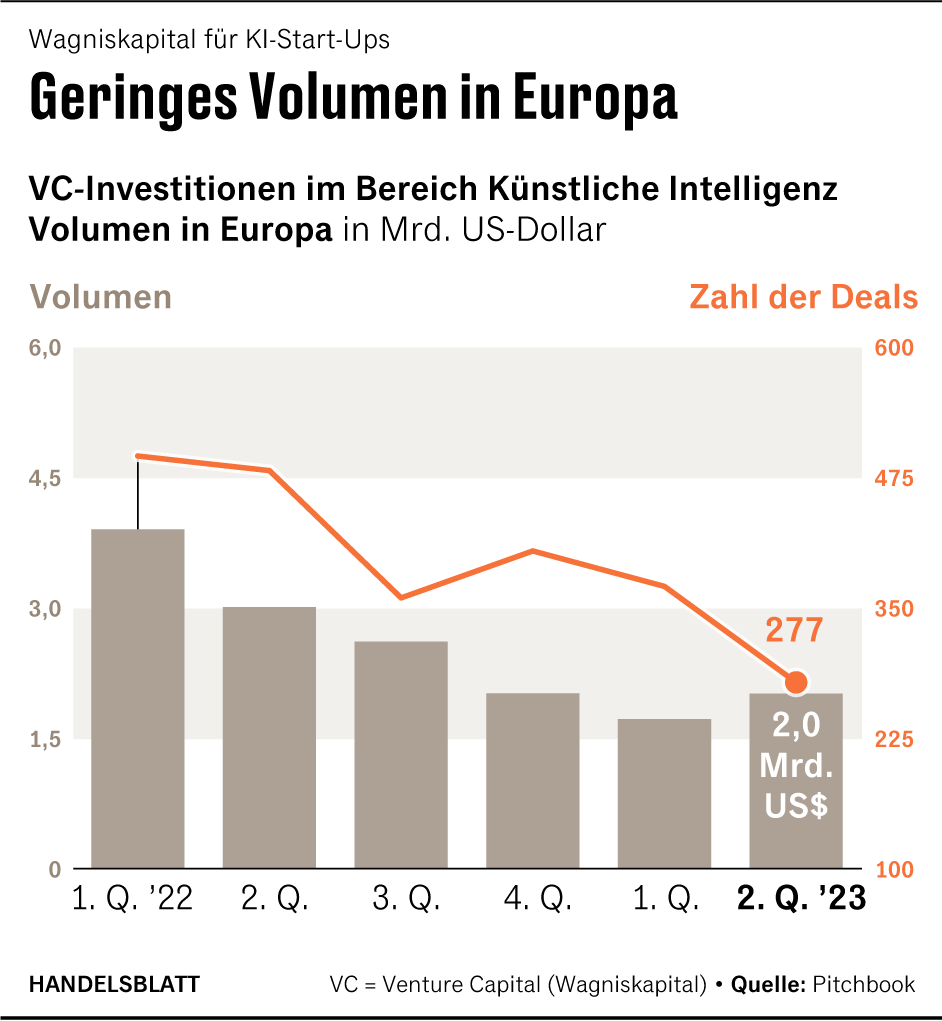New York 2023 is the year of AI hype. At the end of November 2022, Microsoft partner OpenAI ChatGPT will be launched. Anyone can use artificial intelligence (AI) based text bots. This has triggered a wave of global AI applications, as well as a wave of investment in corresponding companies.
However, despite promising start-ups such as London’s StabilityAI and Cologne’s DeepL, Europe is falling further behind in investment in AI companies, according to an exclusive Handelsblatt review by analytics firm Pitchbook.
According to this, there will be 1,129 venture capital deals in the US artificial intelligence and machine learning (ML) field in the first half of 2023. $30.8 billion flowed into corresponding start-ups. That’s a huge advantage compared to the second half of 2022: 1,249 deals worth $15.6 billion, but only half of the investments were concentrated.
The situation in Europe is different. In the first half of 2023, 646 transactions attracted $3.7 billion in gold. Not only is significantly less money flowing into AI than in the US, the pace of investment in Europe even slows down in 2023: in the second half of 2022, the total value of 761 deals still amounts to $4.6 billion.
The development came as a shock to observers. The surprise is not in absolute numbers: the fact that European start-ups have less capital at their disposal is nothing new – US capital markets are simply more developed, and investors have traditionally been more willing to take risks. Instead, the problem is that in the AI hype year of 2023, venture capital funding in Europe will see a decline, rather than a massive increase as seen in the US.
Google, Meta, Apple’s impact: Weakness in European AI investment intensifies
“Europe is falling further behind when it comes to the topic of the future of AI,” says Brendan Burke of analyst firm Pitchbook. “Europe also has significant AI researchers, academic institutions and capable founders. Yet , they can’t raise the equivalent of the US.”
Burke attributed the heightened weakness in European investment in 2023 to the “increased tech giant effect,” or the influence of U.S. companies such as Google, Meta and Apple. For one thing, many AI startups were founded by former employees of tech giants. On the other hand, they are willing to invest in promising start-ups so that their developments can be used for internal research – thereby driving the growth of the US artificial intelligence industry.
Europe lacks a similar ecosystem, Burke said. “European research labs haven’t been as successful.” Even European hopefuls like London-based StabilityAI, the mastermind behind the Stability Diffusion program, can’t close the “big deals” that American competitors can.
StabilityAI reached “unicorn” status after raising $101 million in the fall. An attempt to attract more investment at a higher valuation failed this spring.
And even if European software makers invest, the money doesn’t necessarily flow to Europe. Venture capitalist Sapphire Ventures announced Tuesday that it plans to invest more than $1 billion in startups focused on artificial intelligence, with most of the company’s funding coming from SAP. However, a significant portion of investor deals are done in Silicon Valley.
AI experts: European startups are becoming acquisition targets
What happens to the promising European start-ups that survive the start-up phase? A second assessment created for Handelsblatt by analyst firm Dealogic sees them as takeover candidates.
Dealogic examines the artificial intelligence mergers and acquisitions (M&A) market in the US and Europe. In principle, the U.S. market is also more dynamic, as analyst Kalina Tzerovska explains: In the first half of 2023, $9.3 billion was spent on M&A deals in the U.S. and $3.2 billion in Europe.
On the other hand, European AI start-ups are becoming targets of foreign acquisitions at a faster rate. In the first half of 2023, $1.6 billion will flow into Europe for corresponding M&A transactions. In return, European companies are spending $1 billion to acquire AI specialists in other parts of the world.
The situation in the US is different: only $775 million flowed to the US for M&A. US companies seem to see few attractive acquisition targets in the rest of the world: They just spent $238 million in overseas M&A deals.
Europe: Opportunities for AI Compliance
If these two analyzes are superimposed, the following picture emerges, roughly as follows: AI hype has swept the United States. Venture capitalists invest in founders, and acquisitions occur mostly domestically. On the other hand, Europe lacks both start-ups and funding. If European AI companies succeed, they face the threat of being sold abroad.
Analyst Burke called it a “worrying trend” and he didn’t think the solution would be easy. Of the AI startups he sees as the most promising — OpenAI, Anthropic, CharacterAI, AI21 Labs and StabilityAI — only the latter is from Europe. “The field of artificial intelligence is a very consolidated field. A small number of companies drive most of the innovation,” Burke said. US dominant firms also “do not support a broad global start-up ecosystem”.
Still, Europe has a chance to react. Instead of trying to develop a new base model, the so-called “basic model”, founders should focus on adapting leading AI models for enterprise customers, as well as the area of compliance, i.e. how AI complies with rules and laws. The models were Weaviate from Amsterdam and Qdrant from Berlin.
What about European politics? This must stop European talent being poached abroad, for example by offering better terms for founders. “Keep talent in Europe” is the central task.
Assist: Stephen Schur
more: Seven graphs show where global AI development is concentrated



